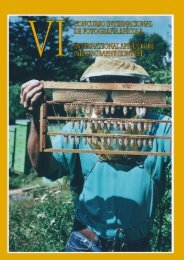VIII Concurso internacional de fotografía apícola, 2008, Catálogo
VIII Concurso internacional de fotografía apícola, 2008, Catálogo
VIII Concurso internacional de fotografía apícola, 2008, Catálogo
- No tags were found...
You also want an ePaper? Increase the reach of your titles
YUMPU automatically turns print PDFs into web optimized ePapers that Google loves.
Título: "Colonias <strong>de</strong> Apis laboriosa en un acantilado <strong>de</strong> abejas en Nepal"Title:"Colonies of Apis laboriosa on a bee cliff in Nepal"125 - CLAIRE WARINGNorthamptonshire - Reino Unido - United KingdomApis laboriosa, la abeja gigante <strong>de</strong> las montañas,se encuentra en algunas partes <strong>de</strong>lHimalaya. Cada colonia construye su nido,consistente en un solo panal al aire libre,suspendido <strong>de</strong> un acantilado. El panal es protegidopor una cortina <strong>de</strong> abejas que se enganchanunas a otras como si fuera una superposición<strong>de</strong> baldosas. La estructura <strong>de</strong>lnido es similar a la <strong>de</strong> las abejas que anidanen cavida<strong>de</strong>s, con la cría en la parte baja <strong>de</strong>lpanal y la miel almacenada arriba.Las colonias emigran a lo largo <strong>de</strong> los valles<strong>de</strong> los ríos en marzo y noviembre respectivamente,y regresan a los mismos acantiladostemporada tras temporada. Se cree que lapermanencia <strong>de</strong> feromonas las atrae a regresara las mismas ubicaciones.Apis laboriosa, the giant mountain honeybee is found in parts of the Himalayas. Eachcolony builds a nest in the open air consistingof single comb suspen<strong>de</strong>d from a cliffoverhang. The comb is protected by a curtainof bees, clinging to each other in anoverlapping tile formation. The nest structureis similar to that of cavity-nesting bees withthe brood on the lower part of the comb andthe honey stored above.Colonies migrate up and down rivervalleys, in March and Novemberrespectively, and return to the sametowering bee cliffs season after season.It is thought that the lingeringpheromones attract them back to thesame location.- 142 -

















